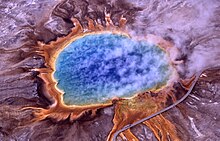This is an old revision of this page, as edited by 68.207.207.137 (talk) at 06:08, 17 November 2006. The present address (URL) is a permanent link to this revision, which may differ significantly from the current revision.
Revision as of 06:08, 17 November 2006 by 68.207.207.137 (talk)(diff) ← Previous revision | Latest revision (diff) | Newer revision → (diff)
The Grand Prismatic Spring in Yellowstone National Park is the largest hot spring in the United States, and the third largest in the world, next to those in New Zealand.
History
There is no doubt that many Native American peoples were aware of the Grand Prismatic Spring long before Europeans first saw it, but the first records of the Spring are from early explorers and surveyors.
In 1839, a group of fur trappers from the American Fur Company crossed the Midland Geyser Basin and made note of a "boiling lake", most likely the Grand Prismatic Spring, with a diameter of 300 feet (91 meters).
In 1870, the Washburn Party, led by General Henry D. Washburn, visited the Spring, noting a 50 foot (15 meter) geyser nearby (later named Excelsior).
Color

The vivid colors in the spring are the result of pigmented bacteria in the microbial mats that grow around the edges of the water. The bacteria produce colors ranging through greens, yellows, oranges, and reds; the amount of color in the microbial mats depends on the ratio of chlorophyll to carotenoids. In the summer, the mats tend to be orange and red, whereas in the winter the mats are usually dark green. The center of the pool is sterile because of its heat.
The deep blue color of the water in the center of the pool results from a light-absorbing overtone of the Hydroxy stretch of water . Though this effect is responsible for making all large bodies of water blue, it is particularly intense here as a result of the high purity and depth of the water in the middle of the spring.
Physical structure
The spring is approximately 250 by 300 feet (75 by 91 m) in size and is 160 feet (49 m) deep. The spring discharges an estimated 560 gallons (2000 l) of 160°F (71°C) water per minute.
References
- "Steam Explosions, Earthquakes, and Volcanic Eruptions—What's in Yellowstone's Future?". U.S. Geological Survey. Retrieved 2005-09-14.
- "VII. "The Fire Hole": Era of the American Fur Company, 1833-1840". Colter's Hell & Jackson's Hole - The Fur Trappers' Exploration of the Yellowstone and Grand Teton Park Region. Retrieved 2005-09-14.
- "Notes". Yellowstone National Park: Its Exploration and Establishment. Retrieved 2005-09-14.
- "Part II: Definitive Knowledge - The Washburn Party (1870)". Yellowstone National Park: Its Exploration and Establishment. Retrieved 2005-09-14.
- Thomas D. Brock. "Colorful Yellowstone". Life at High Temperatures. Retrieved September 14.
{{cite web}}: Check date values in:|accessdate=(help); Unknown parameter|accessyear=ignored (|access-date=suggested) (help) - Braun, Charles L. (1993). "Why Is Water Blue?". Retrieved May 23.
{{cite web}}: Check date values in:|accessdate=(help); Unknown parameter|accessyear=ignored (|access-date=suggested) (help); Unknown parameter|coauthors=ignored (|author=suggested) (help) - "Grand Prismatic Spring". Geyser Observation and Study Association (GOSA). 2006. Retrieved May 23.
{{cite web}}: Check date values in:|accessdate=(help); Unknown parameter|accessyear=ignored (|access-date=suggested) (help)